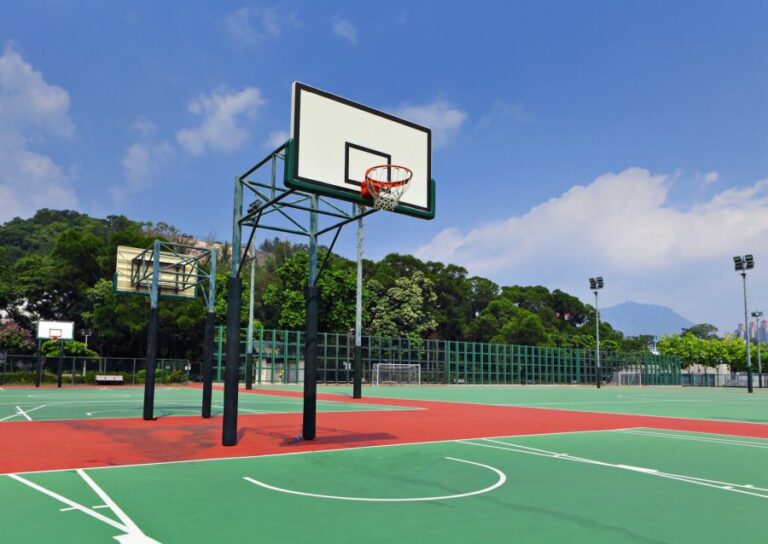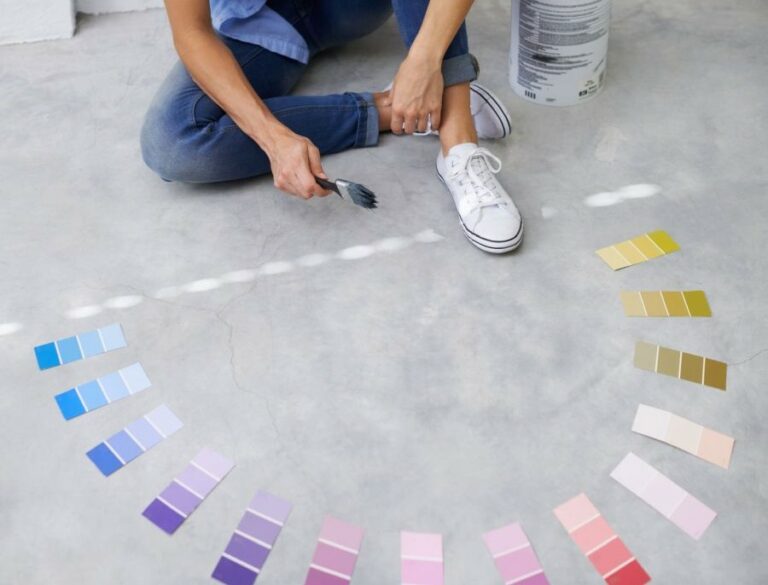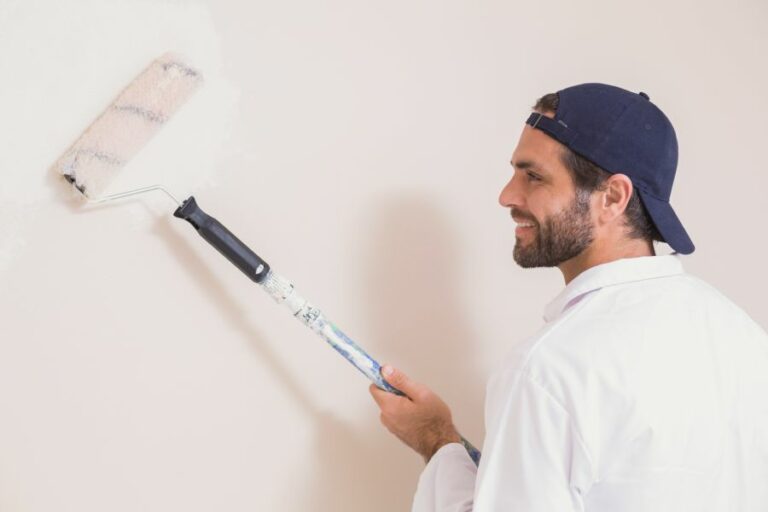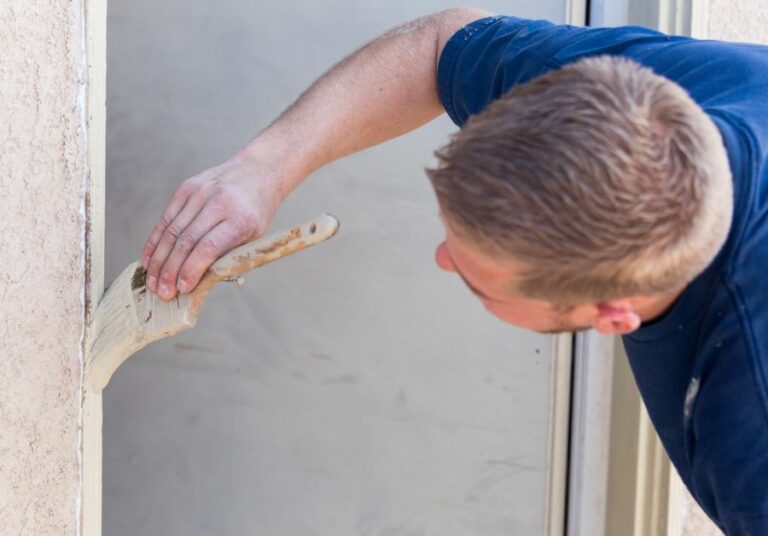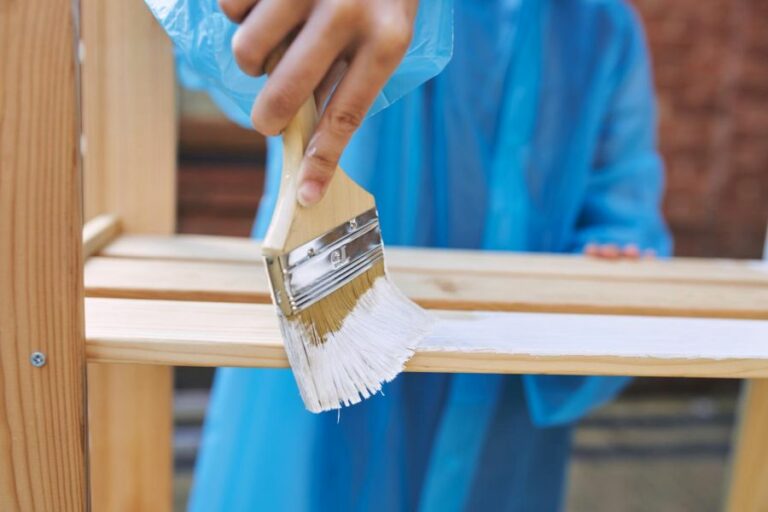Water-Based Outdoor Paint, 25 Things You Should Know
Are you looking for the perfect paint solution for sprucing up your home’s exterior? Look no further, as water-based outdoor paint is your answer. I’m here to help you understand its benefits and why it’s your go-to option for outdoor projects.
Water-based outdoor paint:
Water-based outdoor paint is an eco-friendly, durable, and easy-to-apply option for exterior surfaces. It has lower VOCs, resulting in reduced air pollution and health risks, and is easier to clean up compared to oil-based paints. Types of water-based outdoor paint include acrylic, latex, and elastomeric, each with unique benefits and applications. Proper surface preparation, using quality brushes, and applying multiple coats are essential for the best results.

Discover the benefits and versatility of water-based outdoor paint for your next project! From eco-friendliness to easy clean-up, we’ve got plenty more to share. Keep reading; your perfect finish awaits!
Contents
- 1 Water-Based Exterior Paint for Outdoor Surfaces
- 2 Evaluating the Suitability of Water-Based Paint for Outdoor Applications
- 3 Which Types of Exterior Paints are Water-Based?
- 4 Evaluating the Water-Resistance Properties of Water-Based Paint
- 5 What is the most suitable outdoor water-based paint to use?
Water-Based Exterior Paint for Outdoor Surfaces
Water-based outdoor paint is a popular choice among homeowners and professional painters alike, offering a plethora of benefits over traditional oil-based paints.
• Advantages of Water Based Outdoor Paint
– Environmentally Friendly
One of the most notable advantages of water-based outdoor paint is its environmentally friendly nature. These paints contain a lower quantity of volatile organic compounds (VOCs) than oil-based paints, resulting in reduced air pollution and minimized health risks.
According to the Environmental Protection Agency, VOCs are chemical compounds that evaporate at room temperature, potentially causing various health problems such as headaches, dizziness, and respiratory issues.
By choosing water-based paint, you can significantly reduce these risks and contribute to a healthier living environment.
– Easy Cleanup
Another advantage of water-based outdoor paint is the ease of cleanup. These paints can typically be cleaned with just soap and warm water, making post-painting cleanup a breeze.
This is in stark contrast to oil-based paints, which generally require harsh chemicals such as paint thinner or mineral spirits for cleanup.
– Quick Drying
Water-based outdoor paint dries much faster than its oil-based counterpart. This not only cuts down on the amount of waiting time between coats but also reduces the likelihood of dust, insects, or other debris becoming embedded in the paint during the drying process.
The faster drying times also allow for quicker completion of your painting project, freeing up more time for other tasks or hobbies.
– Easier Application
In general, water-based outdoor paints are easier to apply than oil-based paints. They have a smoother, more uniform consistency that allows for more even coverage, and their flexibility means they are less prone to cracking and peeling over time.
• Types of Water Based Outdoor Paint
There are several types of water-based outdoor paint available on the market, each offering its unique benefits and best uses.
– Acrylic Paint
Acrylic paint is a versatile option that can be used on a variety of surfaces, including wood, metal, and masonry. It offers excellent adhesion and durability, making it an ideal choice for outdoor use.
Some acrylic paints are even specifically formulated to be used for exterior applications, offering enhanced UV protection and weather resistance.
– Latex Paint
Latex paint is another popular choice for outdoor painting projects due to its durability and ease of application. It provides a flexible, breathable finish that allows moisture to escape while still offering excellent protection against the elements.
– Elastomeric Paint
Elastomeric paint is a highly durable and waterproof option that works well on masonry surfaces, such as stucco or concrete. It has a high degree of elasticity, allowing it to expand and contract with temperature changes without cracking.
This makes it an excellent choice for protecting and sealing your home’s exterior from moisture and weather-related damage.
• Application Tips for Water Based Outdoor Paint
To ensure the best results when using water-based outdoor paint, keep these helpful tips in mind during your painting project:
- Proper Surface Preparation: Before you begin painting, it’s essential to prepare the surface properly. This includes cleaning, sanding, and priming as needed to create a smooth, even surface that will ensure proper paint adhesion.
- Use Quality Brushes and Rollers: Investing in high-quality brushes and rollers can make a significant difference in the overall appearance and longevity of your paint job. Look for brushes with synthetic bristles intended for use with water-based paint to ensure a smooth, even application.
- Apply Multiple Coats: To achieve the best coverage and durability, applying multiple coats of water-based outdoor paint is typically recommended. Be sure to allow each coat to dry completely before applying the next one.
- Monitor Weather Conditions: Temperature and humidity can have a significant impact on the appearance and drying time of water-based outdoor paint. Aim to paint on days with moderate temperatures and low humidity for optimal results.
In conclusion, water-based outdoor paint is an environmentally friendly, durable, and easy-to-apply option for exterior painting projects.
By understanding the different types of water-based outdoor paint available and following the proper application techniques, you can achieve a professional-looking finish that will protect and beautify your home for years to come.
Evaluating the Suitability of Water-Based Paint for Outdoor Applications
In recent years, water-based paints have gained significant popularity for their environment-friendly properties and versatility.
As homeowners and professionals alike seek sustainable and visually appealing options for outdoor surfaces, it’s vital to understand the pros and cons of using water-based paint outdoors.
• What is Water-based Paint?
Water-based paint, also known as acrylic or latex paint, uses water as its primary solvent. This type of paint incorporates a combination of water, pigments, and acrylic polymer emulsions to create its distinct formula.
Due to its eco-friendly components, water-based paint emits less odor and fewer volatile organic compounds (VOCs), making it a popular choice among environmentally conscious consumers.
– Environmentally Friendly
One of the significant advantages of using water-based paint outdoors is its minimal environmental impact. Unlike oil-based alternatives, these paints release fewer VOCs, reducing air pollution and making them a safer option for both indoor and outdoor applications.
In addition, many water-based paints are low-VOC or zero-VOC products, meeting strict environmental regulations and earning certification from organizations like Green Seal.
– Easy Application and Cleanup
Water-based paint is known for its ease of application and cleanup. The paint dries quickly, allowing for faster completion of projects. Additionally, since water is the primary solvent in the formula, cleaning up after the project is as simple as using soap and water.
– Superior UV Resistance and Durability
When it comes to outdoor applications, durability is crucial. Water-based paints are known for their excellent UV resistance, meaning they are less likely to degrade due to sun exposure.
Consequently, the colors remain vibrant for a more extended period without fading or yellowing, as some oil-based paints do.
– Resistant to Cracking and Peeling
Another notable advantage of water-based paint for outdoor surfaces is its flexibility. As opposed to oil-based paints, which can become brittle with time and prone to cracking, water-based paints can better withstand environmental conditions such as extreme temperature changes and humidity.
This characteristic makes them suitable for outdoor applications where they are more likely to endure fluctuating conditions.
• Preparing the Surface
When using water-based paint for outdoor applications, proper surface preparation is critical. For the paint to adhere correctly and provide long-lasting protection, the surface must be clean, dry, and free of any debris, mildew, or old paint.
The following steps can help ensure the best results when applying water-based paint outdoors:
- Remove any peeling or loose paint with a scraper or wire brush.
- Sand the surface with medium-grit sandpaper to ensure proper adhesion.
- Clean the surface with a solution of water and mild detergent to remove dirt, grime, and other contaminants.
- Rinse thoroughly with clean water and allow the surface to dry completely.
- Apply a coat of primer specifically designed for use with water-based paint to improve its performance and increase durability.
– Recommended Primers
For optimal results when using water-based paint outdoors, it’s essential to use a high-quality primer designed for exterior surfaces. Some popular primers include:
• Proper Maintenance and Care
As with any exterior surface, regular maintenance and care are necessary to ensure the longevity of your water-based paint job. By taking a few simple steps, you can effectively extend the lifespan of your paint and keep your outdoor surfaces looking fresh and vibrant:
- Inspect the surfaces for any signs of damage or wear, such as cracking or peeling, at least once a year. Address any issues early to prevent more extensive, costly repairs.
- Clean the painted surfaces periodically with a gentle stream of water or a soft-bristle brush and mild detergent. Doing so will help keep dirt, debris, and mildew at bay, ensuring the paint remains vibrant and free of premature aging.
- Avoid using harsh chemical cleaners, as they can strip or damage the paint. Instead, opt for mild, eco-friendly alternatives.
- For best results, consider hiring a professional for periodic maintenance, including inspections, repairs, and cleanings.
• Conclusion
Water-based paint is an excellent option for outdoor applications due to its environmentally friendly properties, ease of application, and UV resistance.
By adequately preparing the surface, using a high-quality primer, and following proper maintenance recommendations, your water-based paint job can provide lasting protection and curb appeal for your exterior surfaces.
Whether you’re a seasoned professional or embarking on your first outdoor project, considering water-based paint for your next endeavor is an eco-conscious and practical choice.
Which Types of Exterior Paints are Water-Based?
• Understanding Water-Based Paint and Its Uses
Water-based exterior paint is a popular choice among homeowners, architects, and contractors, offering excellent adhesion, durability, and ease of application. This type of paint doesn’t rely on chemicals for its solvents, instead using water as its base.
As a result, water-based paints are often chosen for their eco-friendly properties and great performance.
• Key Components of Water-Based Exterior Paint
Water-based exterior paint typically consists of the following components:
- Pigments: These provide color and opacity to the paint. High-quality pigments ensure long-lasting color that won’t fade or chalk over time.
- Binders: These are the main ingredients that hold the paint together and help it adhere to surfaces. Acrylic and latex resins are commonly used as binders in water-based paint. Acrylic resins offer superior adhesion, durability, and weather resistance compared to latex resins.
- Solvents: Water serves as the main solvent in water-based paint. It allows the paint to be easily applied and dries quickly, leaving behind a smooth, solid finish.
- Additives: These are included to enhance the properties of the paint, such as improving flow, leveling, or anti-microbial features.
• Advantages of Water-Based Exterior Paint
Water-based paint offers several advantages over solvent-based or oil-based counterparts, such as:
– Environmentally Friendly
Water-based paint contains fewer volatile organic compounds (VOCs), which are harmful to both humans and the environment. Lower VOCs mean lower risks of allergies and respiratory problems, as well as less impact on the ozone layer.
Check out this environmental guide from the United States Environmental Protection Agency for more information on VOCs and their effects on indoor air quality.
– Faster Drying Time
Water-based paint dries more quickly than oil-based paint, often within a few hours. This allows for faster completion of painting projects and less downtime when it comes to touching up or recoating.
– Easy Cleanup
Cleaning up after using water-based paint is a breeze, as it can be washed away with soap and water.
– Adhesion and Flexibility
Water-based paint has excellent adhesion properties, ensuring it sticks to surfaces well and resists peeling and cracking. It also expands and contracts well with fluctuations in temperature and humidity, maintaining good protection against the elements.
• Recommended Water-Based Exterior Paint Brands and Styles
There are various water-based exterior paint options available on the market, each with its unique properties and styles. Here are some popular brands and recommendations:
– Sherwin-Williams Emerald Exterior Acrylic Latex Paint
This high-quality acrylic latex paint offers excellent durability, weather resistance, and adhesion. It also comes in a wide range of colors and finishes, making it versatile for various exterior surfaces.
– Behr Premium Plus Ultra Exterior Paint & Primer in One
This paint combines both paint and primer in one, simplifying the painting process and providing excellent adhesion and coverage. It also boasts exceptional resistance to mildew, fading, and cracking.
– Benjamin Moore Regal Select Exterior Paint
This low-VOC paint is highly durable, mildew-resistant, and can withstand harsh weather conditions. It also offers excellent color retention and easy application.
• Tips for Applying and Maintaining Water-Based Exterior Paint
To ensure the best results when using water-based exterior paint, follow these simple tips:
- Prepare the surface: Clean and remove any dirt, mildew, or loose paint from the surface to ensure proper adhesion.
- Prime if necessary: Although many water-based paints come with built-in primers, it may be necessary to prime certain surfaces such as raw wood, chalky surfaces, or when making a significant color change.
- Apply under appropriate weather conditions: Avoid painting in extreme heat, cold, or high humidity. These conditions can impair the paint’s adhesion, drying time, and overall performance.
- Use the right tools: Use high-quality brushes, rollers, and other painting tools to ensure a smooth and even application.
- Maintenance: Conduct regular inspections of your painted surfaces and quickly address any signs of peeling, chipping, or fading to prolong the life of your paint job.
In conclusion, water-based exterior paint is a versatile and eco-friendly option for painting the exterior of your home or building. It offers excellent adhesion, durability, and ease of use, making it a popular choice among professionals and DIY enthusiasts alike.
Consider the wide range of recommended brands and styles when choosing the right water-based paint for your project, and follow the tips for application and maintenance to ensure a long-lasting, beautiful finish.
Evaluating the Water-Resistance Properties of Water-Based Paint
Water based paints, often referred to as latex or acrylic paints, have undergone a significant evolution in the last few decades, making them the preferred choice for various projects that demand durability and resistance.
The versatile nature of these paints has sparked a myth or a critical question amongst homeowners and professionals alike: Is water based paint waterproof?
• Understanding Water Based Paints
Water based paints, as the name suggests, are made up of a mixture of water and various binders, such as acrylic or vinyl polymers, which provide the necessary adhesion, consistency, and coverage.
They are known for being environment-friendly and non-toxic, with very low levels of volatile organic compounds (VOCs). Also, they are easy to clean and maintain in comparison to their solvent-based counterparts like oil-based paints.
– Advantages of Water-Based Paints
The following are some of the advantages of water-based paint, which make it a popular choice amongst DIY enthusiasts and professionals:
- Quick Drying: Water-based paints usually dry faster, making it easier to apply multiple coats within a short period.
- Environment-Friendly: they have a low level of harmful VOCs, making them a better choice for indoor and outdoor projects.
- Easy to clean: soap and water are sufficient to clean these paints, reducing the need for toxic solvents and thinners.
- Flexibility: they offer better adaptability to shrinking and expanding surfaces, making them suitable for a wide range of substrates.
– Disadvantages of Water-Based Paints
Despite their numerous advantages, water based paints have some downsides that need consideration;
- Sensitivity to temperature and humidity: these paints need optimal conditions for proper drying and adhesion.
- Limited resistance to wear and tear: depending on the quality, they might not provide the same level of durability as oil-based paints.
- Multiple coats might be required to achieve desired coverage and appearance.
• Is Water Based Paint Waterproof?
Knowing the components of water-based paint, it is natural to wonder about its waterproof ability. The simple answer is water-based paints are not inherently waterproof. However, they are water-resistant to a certain extent.
Once the water-based paint dries, the water in the mixture evaporates, leaving behind the binders (acrylic or vinyl) that form a sort of protective plastic film. This film has resistance to water and humidity but does not provide complete waterproofing.
– Factors that Affect Water Resistance of Water-Based Paints
The extent of water resistance in water-based paints depends on various factors:
- Quality of the paint: Higher quality paints that contain higher concentrations of binders offer better water resistance.
- Number of coats applied: Multiple coats of paint create a thicker protective film, which improves water resistance.
- Surface preparation: Properly preparing and priming the surface ensures better adhesion and in turn, enhances the water-resistant capabilities of the paint.
• Enhancing the Water Resistance of Water Based Paints
Though water-based paints are not inherently waterproof, there are steps that can be taken to enhance their water resistance and protection:
- Use high-quality water-based paint with a higher concentration of binders.
- Apply multiple coats, allowing each coat to dry completely before applying the next.
- Consider adding a waterproofing paint additive to your paint mix. These additives are designed to increase the water resistance of water-based paints without affecting their finish and characteristics.
- Seal the painted surface with a water-resistant topcoat or sealant. There are various sealants available on the market that can provide an additional layer of protection against water and humidity.
• Conclusion
While water-based paints may not be waterproof, they do offer a certain level of water resistance that might be sufficient for various indoor and outdoor projects.
By following the recommendations mentioned above, you can enhance the water resistance of water-based paint and ensure a long-lasting finish for your projects.
However, for projects that demand complete waterproofing, you should consider using specialized waterproof paints or coatings. Consult with professionals if you are unsure about the best paint choices for your specific requirements.
With proper research and technique, water-based paints can deliver excellent results for a vast array of projects.
For more information on paints and their waterproof capabilities, the EPA’s guide on paints and coatings offers valuable insights on choosing environmentally friendly products with appropriate protection features.
What is the most suitable outdoor water-based paint to use?
Painting the exterior of a building is a challenging task that should be approached with care and planning. When it comes to choosing the best water paint for outside use, there are several factors to consider.
• Understanding Water-Based Paints
Before diving into the top exterior water-based paints, it’s crucial to understand what makes water-based paints an excellent choice for outdoor applications.
Water-based paints, also known as latex or acrylic paints, consist of pigment and binder suspended in water. As the paint dries, the water evaporates, leaving behind a durable and long-lasting paint film.
Water-based paints have gained popularity in recent years due to their environmentally friendly nature, low VOC (volatile organic compound) content, and easy cleanup with water.
Additionally, they offer excellent color retention, are less prone to cracking, and have a quicker drying time compared to oil-based paints.
More information on water-based paints can be found on the U.S. Environmental Protection Agency’s website.
• Top Exterior Water-Based Paints
When looking for the best water paint for outside, consider the following top-rated options, which have been evaluated based on their durability, coverage, resistance to environmental factors, and ease of application.
1. Sherwin-Williams Duration Exterior Acrylic Coating
Sherwin-Williams Duration is a premium exterior acrylic coating known for its remarkable durability and resistance to harsh weather conditions. This paint is designed with PermaLast technology, delivering superior adhesion and flexibility that helps prevent cracking, blistering, and peeling.
The Duration line also offers impressive dirt and mildew resistance along with advanced UV protection, ensuring the paint’s longevity and color retention.
I recommend using Sherwin-Williams Duration for large outdoor projects that require top-notch performance and resistance to external elements.
2. Behr Premium Plus Exterior Paint and Primer in One
For homeowners seeking a reliable and cost-effective option, Behr Premium Plus Exterior Paint and Primer in One is a great choice. This 100% acrylic paint offers excellent adhesion, coverage, and weather protection, while the built-in primer ensures a smooth and even finish.
Its mildew-resistant finish is ideal for humid climates or areas prone to mold and mildew growth.
Choose Behr Premium Plus for your mid-range outdoor painting projects that require a balance of quality performance and affordability.
3. Benjamin Moore Aura Exterior Paint
Aura Exterior Paint by Benjamin Moore is a high-end solution favored by professional painters for its excellent coverage and exceptional color retention. The paint utilizes Benjamin Moore’s proprietary Color Lock technology, which offers richer colors that resist fading, even in harsh sunlight.
The Aura line also provides excellent resistance to mildew and staining and has superior adhesion qualities that minimize peeling and cracking.
Consider Benjamin Moore Aura if you require a premium exterior paint that delivers outstanding color and durability for your most important projects.
4. Valspar Duramax Exterior Paint
Valspar Duramax is a well-rounded exterior paint that offers excellent coverage, durability, and resistance to both mildew and dirt.
Its unique formula contains advanced UV protection, which prevents fading and chalking, while the flexible finish allows for expansion and contraction of the painted surface, minimizing the risk of cracking.
Opt for Valspar Duramax when tackling outdoor projects that require high-performing, versatile exterior paint that can withstand the test of time.
• Tips for a Successful Exterior Paint Job
To achieve the best results when using water-based paints, consider the following tips:
- Always properly clean and prepare the surface before painting. Remove any dirt, mildew, or loose paint to ensure optimal adhesion.
- Use a high-quality brush or roller designed for water-based paints to avoid brush marks or roller stippling.
- Work in favorable weather conditions, avoiding extreme temperatures or high humidity. Check the paint manufacturer’s recommendations for the ideal temperature range for the application.
- Allow sufficient drying time between coats, as specified by the paint manufacturer.
• Final Thoughts
By considering factors such as durability, coverage, environmental resistance, and ease of application, you can confidently choose the best water paint for your outdoor project.
Whether you opt for Sherwin-Williams Duration, Behr Premium Plus, Benjamin Moore Aura, or Valspar Duramax, rest assured that these water-based paint options are reputable choices that will provide long-lasting and attractive results.

